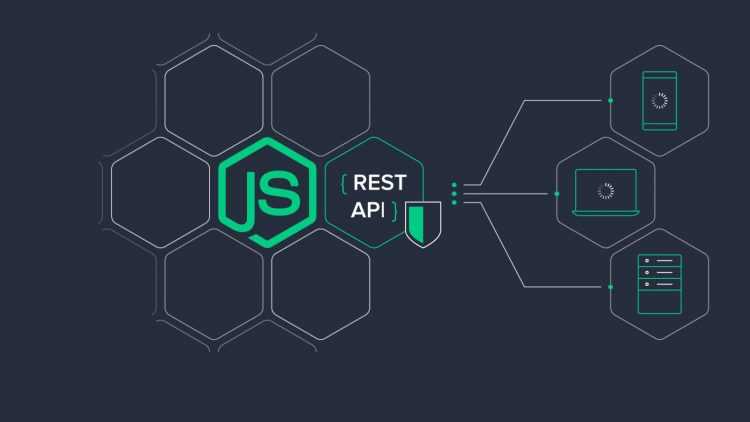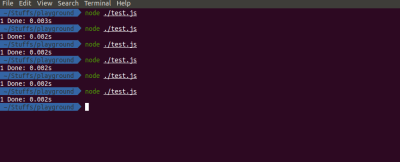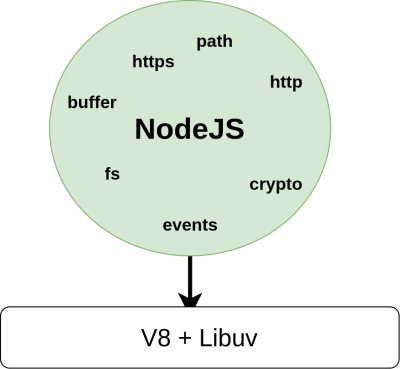Pros
1. Easy Scalability
It is easy to scale any type of application in all directions. You can add some nodes to scale up the app in a horizontal way. It is possible to add additional resources for vertical scaling. Undoubtedly, it makes an app scalable, and this option is relatively better than other JavaScript servers.
2. Simple to Learn
This programming language is considered to be very simple as compared to others. Anyone can learn its codes and do various web development projects.
If you are planning to start using this programming language, consider it as a backend. It is relatively simple to learn and implement codes of Node.js. Within less time, you can create the modules and work with them.
3. High Performance
Many people know that Node.js is an interpretation of JavaScript code by the V8 JavaScript engine of Google. The search engine adds the entire code of JavaScript into its machine code.
It is the best way of implementing the code that ensures high performance at the same time. The execution runs with ease as it supports all types of input and output operations.
4. Caching
You can get an open runtime environment in Node.js along with caching all types of single modules. The memory requests to cache the module, and it is easy to follow the request.
There is no need to execute the codes repeatedly. It is possible to develop and load various web pages and give responses to users quickly.
5. Easy Development of Apps
The developers have the freedom to develop any application type with ease by using Node.js. It is possible to start any project from the beginning. You can create all the modules with ease.
 Source: dev.to
Source: dev.to
Is Node.js Single-Threaded?
Sitting on libuv and V8, Node.js has access to some additional functionalities that a typical JavaScript engine running in the browser does not have.
Any JavaScript that runs in a browser will execute in a single thread. A thread in a program’s execution is just like a black box sitting on top of the CPU in which the program is being executed. In a Node.js context, some code could be executed in as many threads as our machines can carry.
To verify this particular claim, let’s explore a simple code snippet.
In the snippet above, we are trying to create a new file on the disk in the current directory. To see how long this could take, we’ve added a little benchmark to monitor the start time of the script, which gives us the duration in milliseconds of the script that is creating the file.
If we run the code above, we will get a result like this:

This is very impressive: just 0.003 seconds.
But let’s do something really interesting. First let’s duplicate the code that generates the new file, and update the number in the log statement to reflect their positions:
If we attempt to run this code, we will get something that blows our minds. Here is my result:

First, we will notice that the results are not consistent. Secondly, we see that the time has increased. What’s happening?
What are you waiting for? Go learn Node now!
So there you have it. The 6 major reasons why Enterprise companies love Node, and why you should still learn it today, ASAP.
Check out my complete Node.js course here (updated for 2024), or watch the first few videos here for free.

Of course I’m biased but I strongly believe this is the only Node JS course you need to learn Node, build advanced large-scale applications from scratch & get hired as a Back-end Developer. All you need is some basic JavaScript knowledge, and a desire to learn.
Better still. You’ll also get direct access to me, other students, and current Node.js developers via our private Discord channel.
Interesting APIs For Server-Side Programs
If we study a little history of JavaScript, we would know that it’s meant to add some functionality and interaction to a page in the browser. And in the browser, we would interact with the elements of the document object model (DOM) that make up the page. For this, a set of APIs exists, referred to collectively as the DOM API.
The DOM exists only in the browser; it is what is parsed to render a page, and it is basically written in the markup language known as HTML. Also, the browser exists in a window, hence the object, which acts as a root for all of the objects on the page in a JavaScript context. This environment is called the browser environment, and it is a runtime environment for JavaScript.

In a Node.js environment, we have nothing like a page, nor a browser — this nullifies our knowledge of the global window object. What we do have is a set of APIs that interact with the operating system to provide additional functionality to a JavaScript program. These APIs for Node.js (, , , , , and so on), as we have them, exist only for Node.js, and they are provided by Node.js (itself a runtime) so that we can run programs written for Node.js.
How to Render Static Files in Express
This section introduces us to the concept of static file rendering using Express.
First, you’ll need to create a new project folder. Then you’ll initialize npm using .
Install the Express package and create a file called app.js.
Then you’ll create an app, and listen or start the server on port 3000.
To render static web pages such as HTML, CSS, and JS, create a folder named public in the root directory.
As we’re focusing on only the backend, we will not spend much time on the frontend and will create only an HTML file in the public folder.
We will now import the path module and join the specified paths into one:
Now to render these files, we have to use the following command:
__dirname → returns the current directory
And here’s the output:
Как установить Node.js
- Перейдите на страницу загрузки на официальном веб-сайте Node.js
- Здесь вы увидите два варианта: LTS и Current. Рекомендуем выбрать версию LTS (Long-Term Support), так как она более стабильная и имеет длительную поддержку.
- Далее необходимо выбрать версию для той операционной системы, которая вам подходит: Windows, macOS, Linuх. Либо есть возможность скачать официальный Node.js Docker Image, а также использовать Node.js c дополнительными платформами, например, Linux on Power LE Systems.
- После выбора версии начнется загрузка установочного файл Node.js. Дождитесь завершения загрузки, запустите установочный файл и следуйте инструкциям мастера установки.
- После завершения установки откройте терминал и в командной строке введите команду . Если Node.js успешно установлен, вы увидите версию Node.js, например, v20.2.0 (номер версии может отличаться).
Мы также написали более подробную инструкцию по установке Node.js, посмотреть ее можно в GitHub.
Некоторая история JavaScript
В 1995 году Brendan Eich из Netscape Applicator создал язык JavaScript, который позволил ему работать в веб-браузере — история заняла 10 дней. JavaScript изначально разработана для включения анимации и других операций модели объекта документа браузера (DOM). Вскоре была представлена версия Netscape Enterprise ServerJavascript.
JavaScript был выбран в качестве маркетинговой цели, потому что язык Java Sun широко продвинулся. На самом деле, язык JavaScript на самом деле основан в основном на основе схемы и самоуправления, с поверхностной семантикой, аналогичной Java.
Первоначально многие программисты считают, что JavaScript бесполезно для «фактической работы», потому что интерпретатор JavaScript медленнее, чем скорость скомпилированного языка. Эта ситуация изменилась как ряд исследовательских работ, направленных на ускорение скорости скорости JavaScript. Большинство с открытым исходным кодом Google Chrome V8 JavaScript Engine можно оптимизировать для мгновенного компиляции, встроенного и динамического кода, в какой-то нагрузке, фактически выигрывая код C ++ и в большинстве случаев Python.
Ryan Dahl представил JavaScript на основе Node.js for Linux и Macos в 2009 году, как более масштабируемая альтернатива HTTP-сервером Apache. НПМ, написанный Исааком Шлюэр, запущен в 2010 году. Северная версия Windows Node.js дебютировала в 2011 году.
Радиент имеет, управлять и поддерживает развитие Node.js много лет. В 2015 году проект Node.js был передан в Фонд Node.js и управляется техническим руководством Фонда. Node.js также принимается как проект партнера Foundation Linux. В 2019 году Node.js Foundation и JS Foundation состоит из Фонда OpenJS.
Чем бэкенд на JavaScript отличается от PHP и Python
Если в браузере JavaScript тотально доминирует, и конкурентов этого языка на фронтенде не видно даже на горизонте, то в бэкенд-разработке ситуация другая. Здесь JS конкурирует с PHP, Python и другими языками.
Бэкенд на JavaScript уступает PHP в популярности. На PHP написаны самые популярные системы управления контентом, включая WordPress, Joomla!, Drupal. Только на WordPress работает около трети всех сайтов в интернете.
PHP не позволяет из коробки писать асинхронный код, поэтому для каждого клиента запускается отдельный процесс. В Node.js с этим проще — благодаря асинхронной модели можно обрабатывать по несколько запросов в базу данных одновременно.
Python считается одним из лучших языков для изучения программирования. Python универсальный: его используют как в веб-разработке, так и в Data Science, Machine Learning и других сферах. Node.js более «заточен» под веб-разработку, особенно под создание серверных приложений, веб-сервисов и API.
Если вам принципиальна скорость обработки данных и необходимо обрабатывать сложные вычисления, стоит выбирать Python, так как у него лучше производительность. Для более быстрой обработки Python использует мощные библиотеки, вроде NumPy и Pandas.
Pros of Using Node.js for Backend Development
According to the Node.js 2018 User Survey, over 85% of respondents use Javascript runtime in their web apps. Furthermore, it was discovered that Node.js’ average usage consistency spanned more than two years, giving it an advantage over its competitors.
Offers High Performance for Real-time Applications
The ability of Node.js-based web apps to multitask is quite beneficial. Its single-threaded, event-driven architecture, unlike other platforms, effectively processes several concurrent requests without clogging RAM. Furthermore, its event-loop and non-blocking I/O operations allow code to be executed at a rate that substantialyl impacts the overall performance of the application. Google has released the V8 benchmark set to improve Node.js speed by introducing quicker execution, better compilers, security patchworks, and the capacity to scale.
Offers Easy Scalability for Modern Application
The cluster module is one of the many characteristics of the cutting-edge technology. It enables load balancing across several CPU cores, making it simple to achieve desired results using smaller modules without exhausting RAM. Furthermore, Node.js uses a non-blocking event-loop system that provides excellent scalability and allows the server to respond to requests quickly.
Offers Community Support to Simplify Development
With millions of active developers in the Node.js community, we can anticipate substantial help from development specialists all over the world to address even the most unusual development difficulties.
NPM, a JavaScript package manager, is the world’s largest package manager registry. It comes with a variety of tools and libraries that we may utilize right away in our project. On GitHub, we’ll also find a wide collection of resources — ready-to-use solutions, codes, modules, libraries, and registries – created by developers to help us get more done with less.
Many big IT companies, such as Amazon, Google, Facebook, and Netflix, support this thriving community, further enhancing the benefits of Node.js. Many open-source solutions have been developed as a result of their contributions. Acceptance by tech behemoths, as well as the development community, has guaranteed the presence and growth of technology in the near future.
Helps in Building Cross-Functional Teams
Node.js provides full-stack development capabilities, allowing us to construct a team that is focused on improving our development life cycle and also letting us respond to problems quickly. This work environment promotes higher productivity and allows us to properly resolve and fix problems. As a result, our time-to-market is more likely to be reduced.
Improves App Response Time and Boosts Performance
With its single-threaded event-loop paradigm, Node.js provides a non-blocking asynchronous architecture while using fewer resources and producing fewer threads. This improves the responsiveness of our program by allowing it to handle several concurrent users.
Major Comparison Between Node.js and JavaScript
| JavaScript | Node.js |
| It is an accessible, bridge, parsed, lightweight, reactive, and web apps programming language. | It’s a bridge, open-source Js runtime environment for executing Js on the server. |
| It’s a programming language, after all. Any browser with a competent browser engine will operate. | It’s a JavaScript translator and environment that includes some valuable libraries for JavaScript programming. |
| It’s most commonly used on client-side servers. | It’s mainly popular on the server-side. |
| The node community does not care about JavaScript. | All node projects represent the JavaScript community. |
| It’s made for creating network-centric apps. | It’s made for real-time data-intensive apps that run on multiple platforms. |
| It’s a new release of the ECMA script that works on the C++-based V8 engine. | C++, C, and JavaScript are used. |
| TypedJS, RamdaJS, and other JavaScript frameworks are examples. | Nodejs modules include Lodash and Express. All of these modules must be imported from npm. |
For more information about Node.js check out our other blog posts Node.js Process.
Ад обратных вызовов
Но что, если нам нужно сделать несколько последовательных асинхронных вызовов? Например, что если бы мы пытались выяснить, к какой викторине относится ответ, и у нас был бы только ответа.
Во-первых, я собираюсь преобразовать в более общую функцию, что бы мы могли передавать в запрос таблицу и столбец, так же как и идентификатор:
Следующая проблема заключается в том, что может возникнуть ошибка чтения из базы данных. Наш код должен знать, была ли ошибка в запросе к базе данных; в противном случае он не должен продолжать запрашивать данные. Мы будем использовать соглашение Node.js о передаче объекта ошибки в качестве первого аргумента нашего обратного вызова. Затем мы можем проверить, была ли ошибка, прежде чем идти дальше.
Давайте возьмём наш ответ с равным и проверим, к какой викторине он относится. Вот как мы можем это сделать с помощью обратных вызовов:
Вау, сколько вложений! Каждый раз, когда мы получаем ответ из базы данных, мы должны добавить два уровня вложенности — один для проверки на наличие ошибки и один для следующего обратного вызова. По мере того как мы связываем всё больше и больше асинхронных вызовов, наш код становится всё глубже и глубже.
Мы могли бы частично предотвратить это, используя именованные функции вместо анонимных, что уменьшило бы вложенность, но сделало бы наш код менее кратким. Мы так же должны придумать имена для всех этих промежуточных функций. К счастью, в 2015 году в Node появились промисы, помогающие с подобными асинхронными вызовами.
Как не надо использовать обратные вызовы
Давайте завернём этот код в функцию, в которую мы можем передать идентификатор викторины в качестве аргумента; мы хотим получить доступ к любой викторине по её идентификатору. Эта функция возвращает объект строки базы данных, который мы получаем из базы данных.
Здесь мы начинаем сталкиваться с проблемами. Мы не можем просто вернуть объект внутри обратного вызова, который мы передаём в , и уйти. Это не изменит того, что возвращает наша внешняя функция. Вместо этого нужно подумать, что мы можем создать переменную (назовём ей ) во внешней функции и переназначить её в обратном вызове. Вот как мы можем это реализовать:
Если вы запустите этот код, в консоль будет выведено ! Что случилось?
Мы столкнулись с несоответствием между ожидаемым выполнением JavaScript(сверху вниз) и тем, как выполняются асинхронные обратные вызовы. Функция в приведённом выше примере работает следующим образом:
-
Мы объявляем переменную с помощью . Мы ничего не присваивали этой переменной, поэтому её значение .
-
Мы вызываем функцию . Передаём её строку SQL, идентификатор и обратный вызов. Но наш обратный вызов ещё не запускается! Вместо этого пакет запускает в фоновом режиме задачу для чтения из файла . Чтение из файловой системы занимает относительно много времени, поэтому этот API позволяет нашему коду продолжить исполнение, пока Node.js читает с диска в фоновом режиме.
-
Наша функция возвращает . Поскольку наш обратный вызов ещё не запущен, результат все ещё .
-
SQLite заканчивает чтение из файловой системы и запускает переданный нами обратный вызов, закрывая базу данных и присваивая переменной . Присвоение этой переменной значения не имеет, так как функция уже вернула значение .
Unode.js пакет экосистемы
Реестр NPM содержит более 1200 000 бесплатных, многоразовых пакетов кода Node.js, сделать его крупнейшим в мире программным реестром
Обратите внимание, что большинство NPMПакет программного обеспечения (В основном, элемент ключа реестра NPM, который содержит программу, содержащую файл package.json), содержит несколькоМодуль (использоватьПрограммы, загруженные заявлениями). Путаница этих двух терминов легко, но в этом случае у них есть конкретные значения и не должны быть взаимозаменяемыми
NPM может управлять программным пакетом локальных зависимостей как конкретные проекты и глобально установленные JavaScript Tools. При использовании в качестве диспетчера зависимости для локального проекта NPM может установить все зависимости для проекта в команде через файл Package.json. NPM обычно требуется привилегия System (Sudo) при использовании для глобальной установки.
тыНе обязательноИспользуйте командную строку NPM для доступа к публичному реестру NPM. Другие менеджеры пакетов (такие как пряжа Facebook) предоставляют альтернативный клиентский опыт. Вы также можете использоватьСайт NPMПоиск и просматривайте пакеты.
Почему вы хотите использовать пакеты NPM? Во многих случаях установите пакет через командную строку NPM, является самым быстрым, наиболее удобным, а укушенным источником источника, который запускает модуль в среде и создает установленную рабочую нагрузку из репозитория. Если вы не хотите использовать последнюю версию, вы можете указать номер версии для NPM, который особенно полезен, когда пакет зависит от другого пакета и может быть прервана более новыми версиями.
Например, экспресс-каркас представляет собой самую маленькую и гибкую структуру веб-приложения Node.js, которая предоставляет набор мощных функций для создания одной страницы и нескольких страниц и смешанных веб-приложений. Хотя репозиторий ExpressCode, который легко клону, этоhttps://github.com/expressjs/express И экспресс-документ находитсяhttps://expressjs.com/ Однако быстрый способ начать использовать Express — это установить его для его использования.Команды инициализируют локальный каталог разработки работы, например:
Параметры на самом деле включены по умолчанию в NPM 5.0 и позже, что сообщает Manager Package добавлять модуль Express в список зависимостей файла Package.json после установки.
Еще один быстрый способ начать использовать Express — это исполняемый файл глобальной установкиСтроитель Затем используйте его для создания приложения локально в новой рабочей папке:
Как только это сделано, вы можете установить все необходимые зависимости и запустить сервер, используя NPM в соответствии с содержимым файла Package.json, созданный Builder.
Трудно выбрать точки в миллионах пакетов NPM, но несколько категорий более заметны. Экспресс — самый старый и выдающийся пример ody.js framework. Другим основным классом в репозитории НПМ является утилитой разработки JavaScript, включая Browserify Bundlers модулей. Bower, диспетчер пакетов браузера; Grunt, JavaScript задача запущена программа; И глотал, потоковое строительство системы. Наконец, для разработчиков Enterprise Node.js важные категории являются клиентами базы данных, в том числе более 8 000, включая популярные модули, такие как Redis, Mongoose, Firebase и PG, PostgreSQL Clients.
Версия Node
Самое разительное отличие серверного программирования от клиентского заключается в том, что вы сами определяете свою среду выполнения и можете быть абсолютно уверены в поддерживаемых функциях. Именно вы выбираете, какую версию программного обеспечения использовать, в зависимости от потребностей проекта и возможностей сервера.
У Node.js есть публичный , из которого видно, что нечетные версии не имеют долгосрочной поддержки. Текущая LTS-версия (long-term support) будет активно разрабатываться до апреля 2019 года, а затем поддерживаться до 31 декабря 2019 года.
В свежих версиях Node появляется много новых функций, обновлений безопасности и улучшений производительности, поэтому очень полезно использовать текущую активную версию. Тем не менее, никто не заставляет вас делать это, нет ничего плохого в том, чтобы использовать старую версию и игнорировать обновления, если они вам не нужны.
Node.js широко применяется в современном фронтенде – трудно найти проект проект, который не использует инструменты этой платформы. Скорее всего, вы уже знакомы с nvm (node version manager), который позволяет установить несколько версий Node одновременно для разных проектов. Это полезно, ведь если разные приложения используют разные релизы, было бы сложно синхронизировать и тестировать их на одной машине. Такие инструменты существуют и для многих других языков, например, virtualenv для Python, rbenv для Ruby.
Frequently Asked Questions (FAQs)
1. How is JavaScript different from Node.js?
JavaScript is a client-side scripting language that is lightweight, cross-platform, and interpreted. Node. On the other hand, Js is a server-side scripting language built on the V8 engine.
2. Is JavaScript better than Node.js?
Javascript is a computer language that may be used to create website scripts. NodeJS is a runtime environment for Javascript. Both are crucial and intertwined.
3. What is the significant difference between Node.js and JavaScript?
JavaScript is a simple programming language that runs on any browser’s JavaScript engine. While Node JS is a JavaScript interpreter or runtime environment, it requires libraries readily available from JavaScript programming to be more helpful.
4. Is Node.js easier
If you already know how to use JavaScript, learn to use Node. Js is a lot easier. Yes, it is simple.
5. Is JavaScript backend?
JavaScript is a programming language that may be used on both the front and back end.
What is Node.js?
For executing JavaScript on the server, Node.js is a bridge, open-source Js runtime environment. JavaScript code can now execute outside of the browser, thanks to Node.js. Node.js has many components and is primarily used for web development. It may run on various operating systems, including Windows, Linux, and Mac OS. It provides a cross-platform runtime environment for developing highly scalable server-side JavaScript applications with event-driven, non-blocking (asynchronous) I/O.
Ryan Dahl invented and popularised Node.js in 2009. Web apps, command-line apps, real-time chat apps, and REST API servers are just a few applications that can be built using Node.js. It is, however, mainly used to create network programs like web servers—Node.js’s standard filename extension is.js. You can enroll in the best node js course online if you find helpful node js.
Что может JavaScript в браузере?
Современный JavaScript – это «безопасный» язык программирования. Он не предоставляет низкоуровневый доступ к памяти или процессору, потому что изначально был создан для браузеров, не требующих этого.
Возможности JavaScript сильно зависят от окружения, в котором он работает. Например, Node.JS поддерживает функции чтения/записи произвольных файлов, выполнения сетевых запросов и т.д.
В браузере для JavaScript доступно всё, что связано с манипулированием веб-страницами, взаимодействием с пользователем и веб-сервером.
Например, в браузере JavaScript может:
- Добавлять новый HTML-код на страницу, изменять существующее содержимое, модифицировать стили.
- Реагировать на действия пользователя, щелчки мыши, перемещения указателя, нажатия клавиш.
- Отправлять сетевые запросы на удалённые сервера, скачивать и загружать файлы (технологии AJAX и COMET).
- Получать и устанавливать куки, задавать вопросы посетителю, показывать сообщения.
- Запоминать данные на стороне клиента («local storage»).
Cons of Using Node.js for Backend Development
Unstable API
The most significant drawback of Node.js is its lack of consistency. The API for Node.js changes regularly, and the updates are frequently incompatible with previous versions. When this occurs, programmers are compelled to make changes to the old code base in order for it to be compatible with the new version.
Reduces Performance When Handling Heavy Computing Tasks
Node.js receives a large CPU-driven task in its event loop; it makes use of all of its CPU power to complete the work. This causes the whole event loop to slow down, further obstructing the user interface of our program.
To address this, Node.js released the «worker threads» module in 2018, which allowed developers to run several threads at the same time. This technique, however, does not fully prepare us to deal with CPU-bound computing difficulties.
Node.js Asynchronous Programming Model Makes It Difficult to Maintain Code
Because of its asynchronous nature, the technology generally responds quickly to callbacks. This function runs only after each task in the queue, allowing numerous queued tasks to continue processing in the background. Callback hell, as it’s often known, could occur as a result of the callback. This has a direct impact on the code’s performance and quality. This constraint makes it difficult to comprehend and maintain the code.
High Demand With a Few Experienced Node.js Developers
Hackerrank has identified the main student talent trends impacting university recruiting each year based on polls of over 10,000 student developers. Every year, students tune into the talent pool and enroll in the industry’s trending demands in order to stay ahead in this competitive market. The tech behemoths are infamous for their fierce competition for top talent, with Amazon, Facebook, and LinkedIn exhibiting each year at the career expo. Unfortunately, demand is outpacing supply, and there aren’t enough experienced Node.js developers to meet the market’s demands.






























